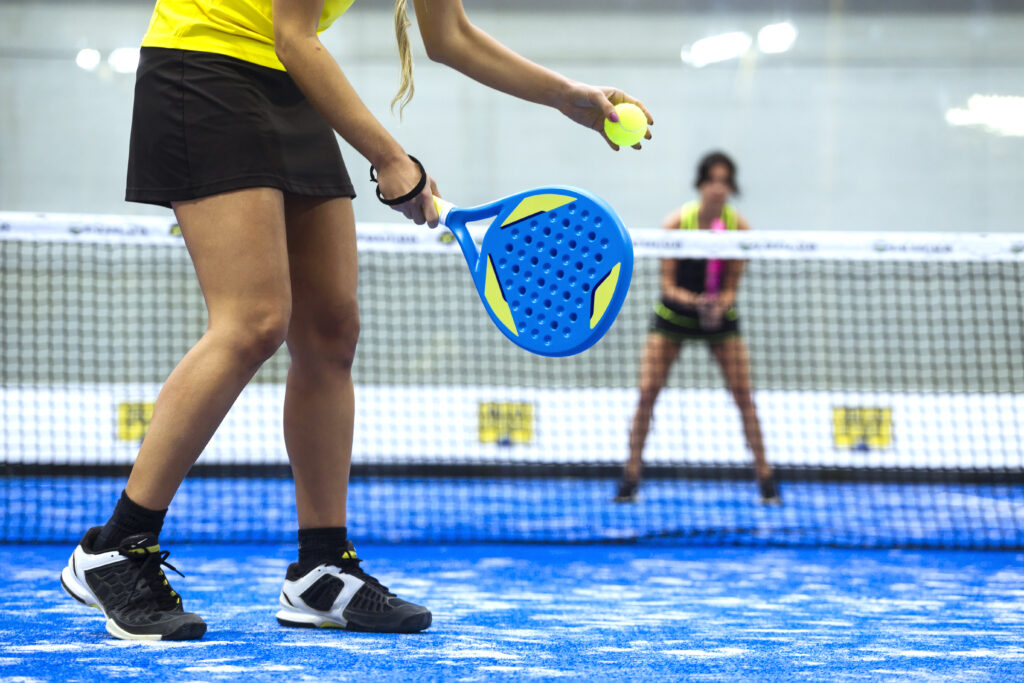Racquet Sports: Padel vs. Pickleball
January 18, 2025
Gustavo Rodriguez
Comparable yet Uniquely Different
Padel and pickleball are two racquet sports that are experiencing rapid growth globally. They may appear similar on the surface, but each has their own set of rules, court dimensions, playing styles, and equipment needed that make each one uniquely different.
Similarities
Both sports can be played indoors and outdoors and
borrow many elements from Tennis. Both are
considered racquet sports served underhand and
typically played as doubles with two players on each
team. Padel and pickleball are both played on
relatively small courts in comparison to their sister
sport, tennis.
2
Differences
While visually similar looking, the rules of play, court layouts, and equipment used are what truly sets padel and pickleball apart.
Service
While both sports require an underhand serve, Padel service occurs behind the baseline and inside the service box. The ball must bounce in the server’s service box and must be hit below waist level. The server may stand anywhere behind the baseline within the boundaries of the court and is allowed one serve. The ball must bounce once in the servers box before it is hit. After crossing the net diagonally, the ball can hit the wall as long as it bounces in the correct service box. This is similar to tennis without the added element of walls. The ‘No Let’ rule allows the ball to be in play if it hits the net as long as it lands in the correct opposite service box.
Pickleball service must land diagonally across the court in the opposite service box without touching the net. Unlike Padel, the pickleball server must serve from one side of the court and serve diagonally across the net. Pickleball is served from behind the baseline in what is considered out-of-bounds during rallies. The server is allowed two service attempts. The ‘Let Serve’ rule in pickleball means if the ball touches the net, but lands in the correct service box, it must be replayed.
Rallies
In Padel rallies are more complex due to the added element of playable walls. The larger size of the court makes padel play like a Tennis/Squash hybrid. Padel games tend to be longer and may require more finesse and strategy.
Pickleball rallies are typically faster with more emphasis on ball placement, spin, and quick reflexes.The kitchen or non-volley zone means players cannot return a ball in this zone without it bouncing first. The kitchen requires forethought in order to avoid faults during play and volleys must be hit without players touching the gameline where the kitchen begins.
3
Scoring
Padel uses a traditional tennis scoring system (15, 30, 40, game) with games played in sets and matches the best of 3 sets.
While traditional tennis scoring is still the official way pickleball games are scored, rally scoring is gaining traction. For 2025, USA Pickelball is provisionally recognizing rally scoring for singles and certain doubles games. In rally scoring a point is awarded to either team regardless of who serves. Games are played to 11, 15, or 21 points and must be won by a two point lead. Games
are played in sets, with the winner of two sets, declared the match winner. Court Size & Layout
Padel courts are 10m (32.8’) wide x 20m (65.6’) long with a court enclosed in glass or rigid mesh to enable ball bounce off of this enclosure. The net is 88 cm (34.6”) at the center and 92 cm (36.2”) at the posts.
Pickleball courts are 20’ wide x 44’ long. The court is divided into service boxes separated by the net and the non-volley zone which extends 7’ in either direction from the net. The net is 34” at the center and 36” at the posts.
Equipment
Padel racquets are commonly made of carbon fiber and plastic and are perforated to reduce air resistance. The ball used is almost identical to a tennis ball, but slightly smaller and is slower to play.
Pickleball paddles are more similar to table tennis paddles than traditional tennis racquets. They are solid and flat and similar in size to Padel racquets although they are more square in appearance. The ball used is similar to a wiffle or floor ball, as it is plastic in nature and perforated.
Established vs Growth Boom
Both sports emphasize precision and strategy and an underhand serve. While they are both seeing rapid growth, Pickleball is established in North America having been developed in
4
Washington state in the 1960s. Padel is still in the early stages of growth. It is established in Spain and Portugal and is seeing rapid growth in Europe, Latin America, and recently in the United States. While they may seem similar on the surface, the rules governing serve attempts, court use, and ball interaction are what truly set them apart.

